Zanzibar is becoming a sustainable tourism hotspot
Here’s why the Tanzanian archipelago is looking to move beyond its backpacker past
If you’re looking for a close encounter with dolphins, you’d struggle to beat Zanzibar. When I first visited this Tanzanian archipelago 15 years ago, a pod (the name for a group of dolphins) passed within feet of my sunbathing spot at Nungwi, on the main island of Unguja.
These days, you probably won’t spy a fin from Nungwi’s white sands. Dolphin-spotting trips still boast of an 85 per cent success rate, but as Hafsa Mbamba, Executive Secretary at the Zanzibar Commission for Tourism, explains: “They rarely come within the reef anymore.”
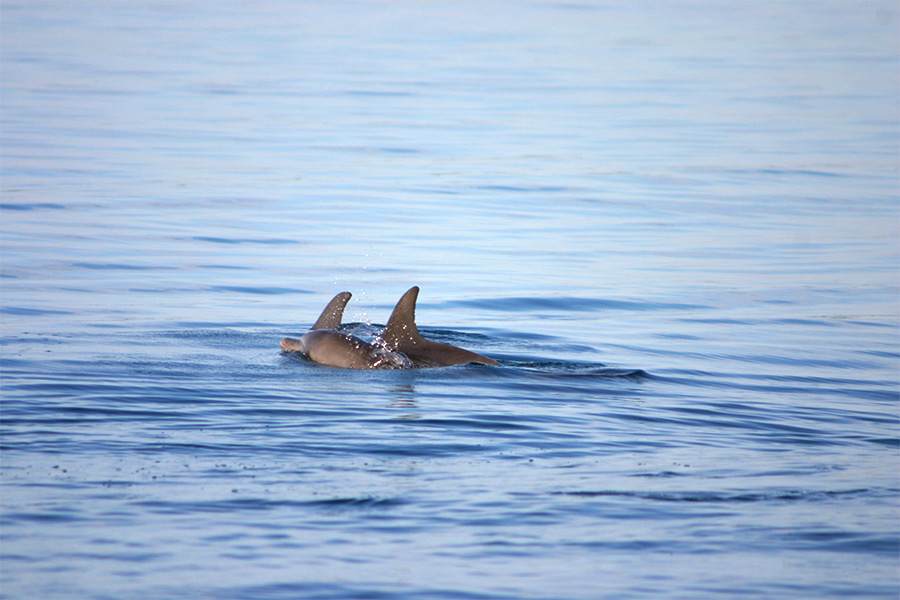
Bottlenose dolphins off Chumbe Island

It’s not surprising. That close encounter a decade-and-a-half ago ended in a literal stampede, with dozens of backpackers launching themselves into the surf, scaring off the frightened family.
The worry is that dolphins may stop coming to the islands altogether. It’s part of the reason why Mbamba and her colleagues created the Zanzibar Declaration on Sustainable Tourism. Unveiled in February 2023, the five-point plan aims to not only reduce tourism’s impact on the islands, but better spread its benefits across the semi-autonomous region.
Many of its aims are things you’d expect, like cutting energy use, protecting native flora and fauna, and asking businesses to swap plastic bottles for glass or refillable alternatives. Others are slightly more ambitious, like plans to cap the number of dolphin-spotting trips and promote more sustainable excursions in their place.
“We want to attract ‘conscious travellers’, who spend more than backpackers,” says Mbamba. “People who buy organic, don’t waste water, want to experience local culture and eat locally produced food.” A staggering 60 to 70 per cent of Zanzibar’s food is currently imported, with much of that strain coming from hotels keen to serve their guests the same dishes year-round, irrespective of seasons.

Zanzibar’s world-class kite-surfing scene in action / Image: ZCT
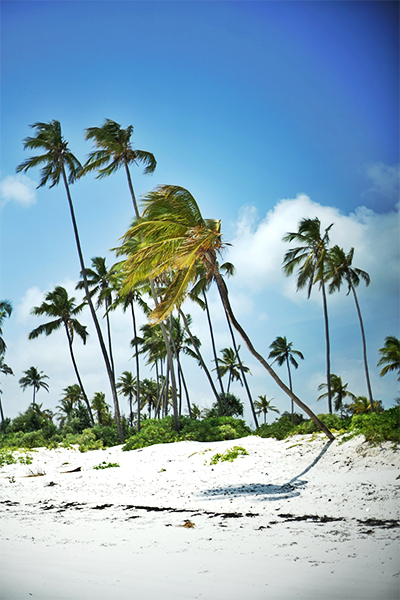
Let’s hope the beaches stay this clean and paradisiacal / Image: ZCT
“We’ve been working with hotels and other partners to get them to pledge to be more sustainable; to serve at least one sustainable dish, to cut out threatened seafood, to stop cutting down native trees and replace ones already lost,” says Mbamba. We’re starting with very basic targets that businesses can reach, based on activities already taking place on the island.”
Those that sign up to the pledge – which is currently being sent out to hotels, restaurants and tour operators – will be awarded something they can use for marketing purposes, like a “green label”, Mbamba explains.
“We couldn’t enforce immediately. First, we want to create awareness.” Part of this awareness campaign involves promoting a wider range of attractions. Less than one in 20 tourists currently engage in any form of cultural activity during their stay. Fewer still take advantage of Zanzibar’s world-class kite-surfing conditions or its eco-tourism potential.
It’s a shame; the islands are full of things to see away from the beach, from tours of historic spice plantations and its UNESCO-protected former capital, Stone Town, to wildlife treks in Unguja’s forests, part of the Jozani-Chwaka Bay National Park, now designated a UNESCO Biosphere Reserve.
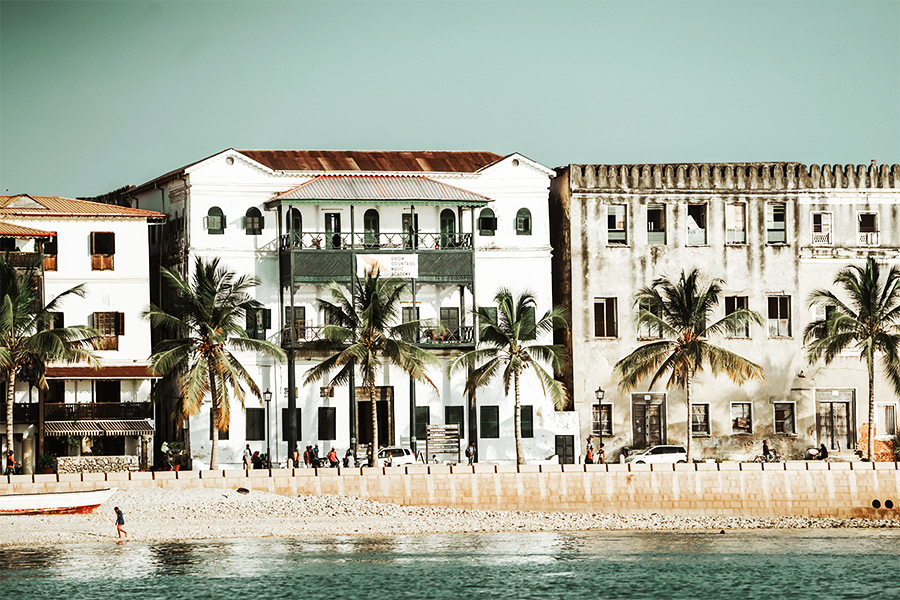
Stone Town / Image: ZCT

Mbamba and her colleagues are confident that by working with hotels and tour guides to push a wider range of attractions to their guests, they can not only boost tourist numbers and the amount each visitor spends (they’ve already managed to swap the old backpacker crowd for wealthier travellers), but also take some of the pressure off those big-ticket draws – like the reefs and dolphins – currently at risk from over-tourism.
In fact, they’re pretty serious on this point: the authorities are already cracking down on unlicensed dolphin-spotting operators, introducing guidelines for the number of boats that can go out each day and educating boat crews on the importance of keeping a respectful distance from marine wildlife (tourists often pressure the crew to let them go swimming with the dolphins, as I witnessed on a 2018 visit to the islands).
The tourist board is also looking at measures to protect Zanzibar’s under-pressure reefs, which are being damaged by the sheer volume of snorkellers and divers visiting them each day. Up to 40 boats can be anchored off Unguja’s main reef, Mnemba, at times, with each carrying a risk of damaging the coral as they drop and raise anchor.
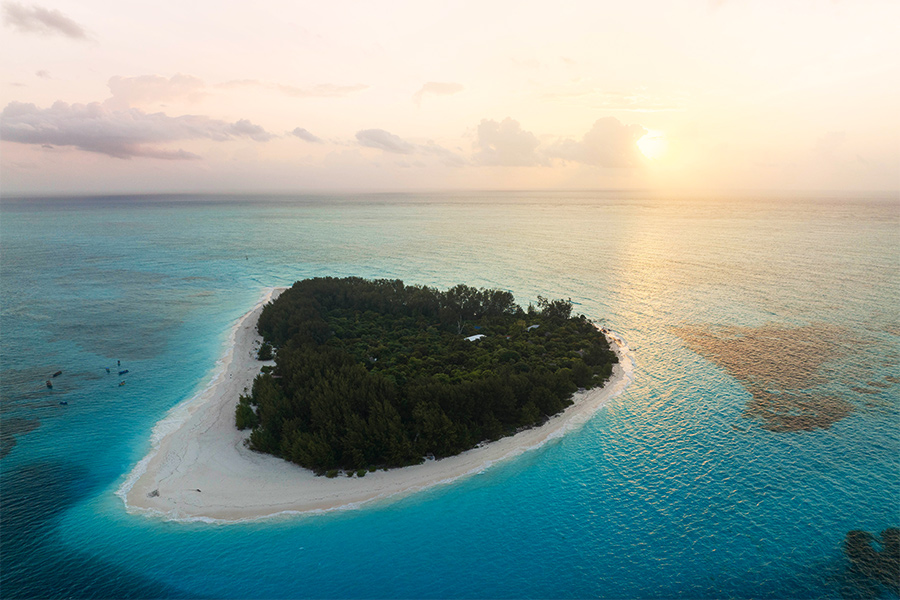
Mnemba Island at sunrise / Image: Getty Images

Again, limits are being considered on the number of visitors, with tourists potentially being pushed towards less invasive alternatives like kayaking in the mangroves instead. The tourist board is also working with marine experts and government agencies on other ways to protect the coral, crucial not only for the future of the dive operators, whose entire business model depends on a healthy reef ecosystem for tourists to see, but also the locals and dolphins who survive on the fish that live and breed among Mnemba’s underwater jungle.
One of the solutions already being trialled at Mnemba is a coral replanting project, where broken fragments are collected from the sea floor, propagated in the lab to encourage them to rapidly re-grow, and later replanted on the reef.
They’re also swapping diesel outboards for reef-safe alternatives, and looking into anchor-free moorings. The latter is already in progress at Unguja’s southern reef, Chumbe, which has deep-water mooring buoys for its boats to dock in. The reef there is managed by Chumbe Island Coral Park (CHICOP), a private reserve and eco-lodge singled out by the United Nations for its reef conservation initiatives.
It’s no wonder. Its seven bungalows are completely off the grid and have practically zero impact on the environment (think rainwater collection, solar heating for showers and composting toilets to avoid any effluence polluting the reef). Entry to this island paradise is also strictly controlled, with no more than 18 people allowed in a day, including day-trippers.
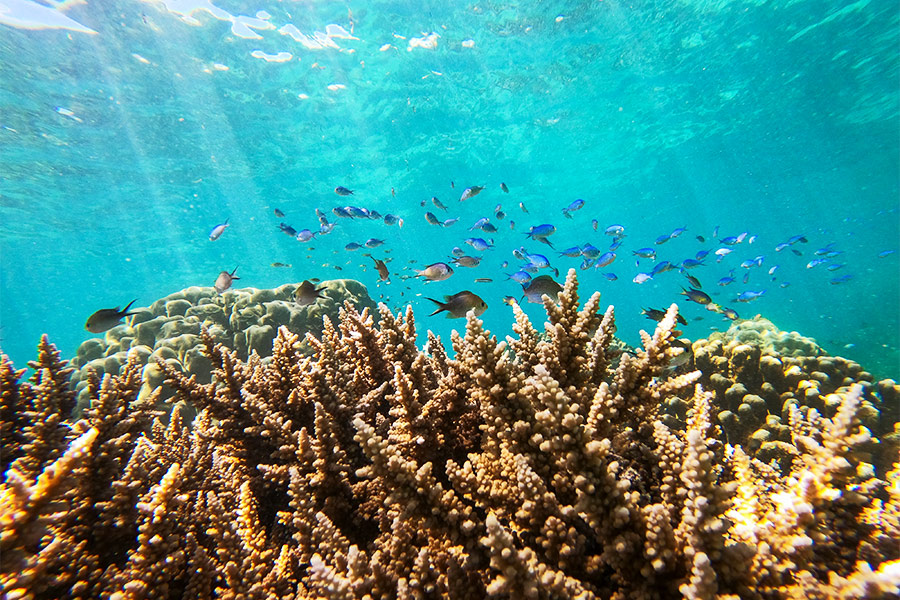
Marine life enjoying Chumbe Coral Park

What’s more, it’s surrounded by a marine protected area (MPA), with a strict no-take policy on one side that local fishermen respect because, as CHICOP’s marketing manager Diana Körner points out, “they see the benefit” in an increased catch on the side they are allowed to fish.
They’re not the only ones reaping the benefits. From the shore, you’ll see the unmistakable silhouettes of dozens of blacktip reef sharks hunting in the shallows; harmless bottom feeders that have been “increasing in population over the past couple of years”, according to Körner. Humpback whales have also started spending longer and longer periods in the waters around Chumbe, often passing so close you can hear them singing as you snorkel.
Of course, with just 18 guests allowed on the island, Chumbe is no alternative to mass tourism. But the team of scientists running the reserve is also working with the tourist board to see whether the whales could one day help take some of the tourist pressure off the dolphins.
“We want to attract ‘conscious travellers’ … People who buy organic, don’t waste water, want to experience local culture and eat locally produced food.”
CHICOP has also been instrumental in creating the sustainable seafood guide, which forms a key tenant of Zanzibar’s new sustainable tourism pledge. Based on a traffic light system, it flags threatened species like sharks and rays as big “red” no-nos, and promotes “green” or “yellow” alternatives at minimal risk of over-fishing. The scheme has already been adopted by some tourist businesses after they were invited to Chumbe for a workshop on the issue.
One such early adopter is Emerson Zanzibar, a company with two locally owned heritage hotels famous for their rooftop restaurants overlooking Stone Town’s labyrinth.
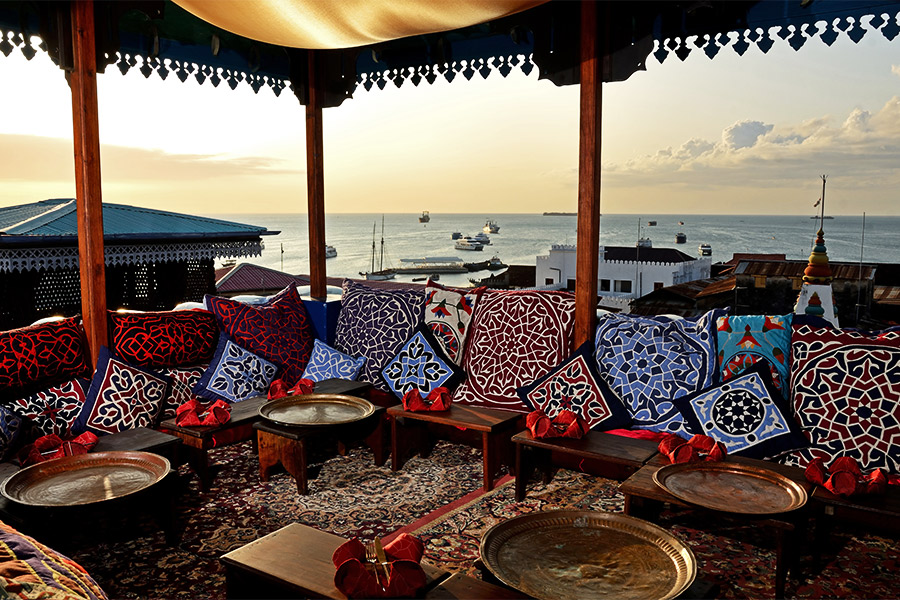
Emerson on Hurumzi Tea House / Image: Andrew Morgan

Hyper-luxe hotel Zuri Zanzibar has also rolled out an entirely sustainable seafood menu. In many ways, this sprawling five-star resort, on the white sands of Kendwa, northern Unguja, couldn’t be more different to Chumbe or other low-frills, ‘eco’ hideaways, such as Pemba Lodge on Shamiani Island. But Zuri is probably a more realistic template for how the new sustainable plan could work in practice, in a region attracting roughly half-a-million visitors annually.
The first hotel in the world to be awarded EarthCheck’s Sustainable Design Gold Certification, Zuri’s luxurious thatched villas are stuffed full of the latest energy-saving mod-cons, like an air-cooling system that uses 75 per cent less electricity than traditional air-conditioning, not to mention locally made furniture, which helps spread the financial benefits of tourism beyond just the service sector.
What’s more, all Zuri’s water, including its drinking water, comes from either its own wells or greywater collection, taking pressure off the local villagers’ water supply. The water is run through a desalination plant, which uses reverse osmosis technology to make the water safe and drinkable. All food waste is also composted, and the resulting fertiliser given to small-scale farmers.
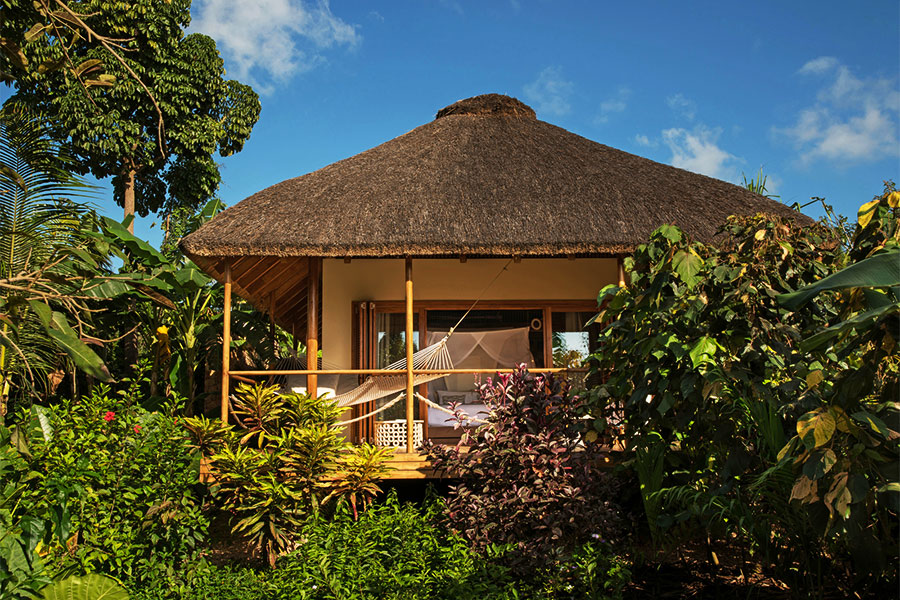
One of Zuri’s luxurious, thatched bungalows / Image: Zuri Zanzibar

Most importantly, the hotel treats all its sewage and waste-water, making it suitable for irrigation – a huge green tick in a region that has only recently begun building municipal waste-water treatment plants, and is surrounded by sensitive coral ecosystems.
Perhaps unsurprisingly, Zuri opts not to put its commendable sewerage system front and centre in adverts. If it mentions ‘green’ issues at all, it sticks to more marketable talking points, like its ban on plastic straws and bottles.
In reality, though, Zanzibar doesn’t actually have a huge plastic problem to worry about. Yes, most restaurants and hotels still give out plastic straws, and water is still sold mostly in plastic bottles – something the government hopes to eventually ban. But its beaches aren’t dotted with detritus like other tropical paradises. The amount of rubbish is, in many ways, comparable to what you’d find in Britain or North America. This is partly thanks to beach clean-ups organised by hotels and kite-surfing schools.
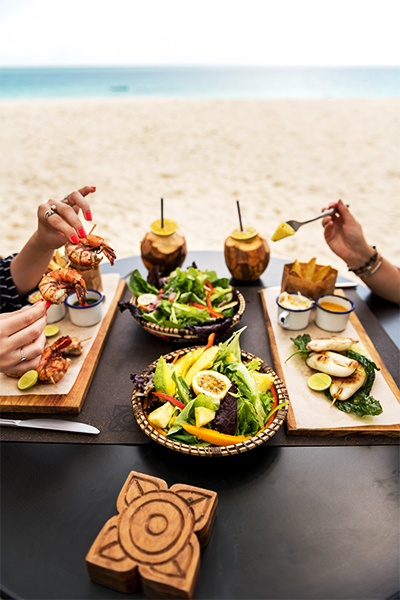
Bahari lunch with a beach view / Image: Zuri Zanzibar
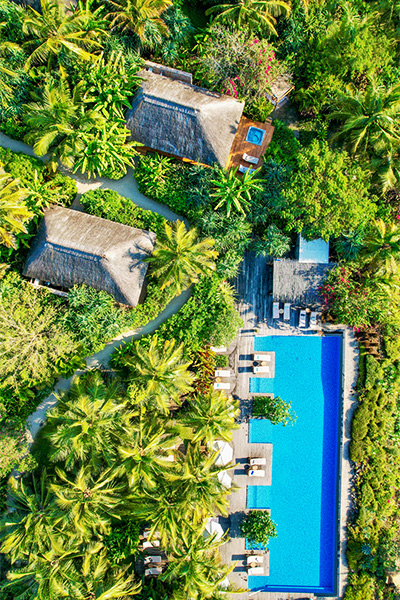
A bird’s-eye view of the infinity pool / Image: Zuri Zanzibar
Meanwhile, the installation of large bins in many of the villages by local government and charities has had a noticeable impact on plastic pollution; I’ve spotted less and less plastic each time I’ve visited Unguja.
That’s not to say the region doesn’t have issues that will need more government intervention if it’s seriously to rival the likes of the Seychelles on sustainability. Almost all the plastic and other waste deposited in those bins is burned in situ. Very little is disposed of in a safe manner.
Another major area for improvement, according to Kiri Belcher, a Kenyan marine biology student who used to live in Zanzibar, is the often “unsustainable” practices used by its fishing industry. She points to the use of harmful nets that “completely rip the corals apart and anything in the way”. Belcher says that such nets used to be common in her Kenyan hometown, Mombasa, until relatively recently. “It was actually a lot easier than we thought convincing fishermen to use alternative nets or fishing methods,” she explains, “provided we gave them the new nets or show them alternate fishing methods”.
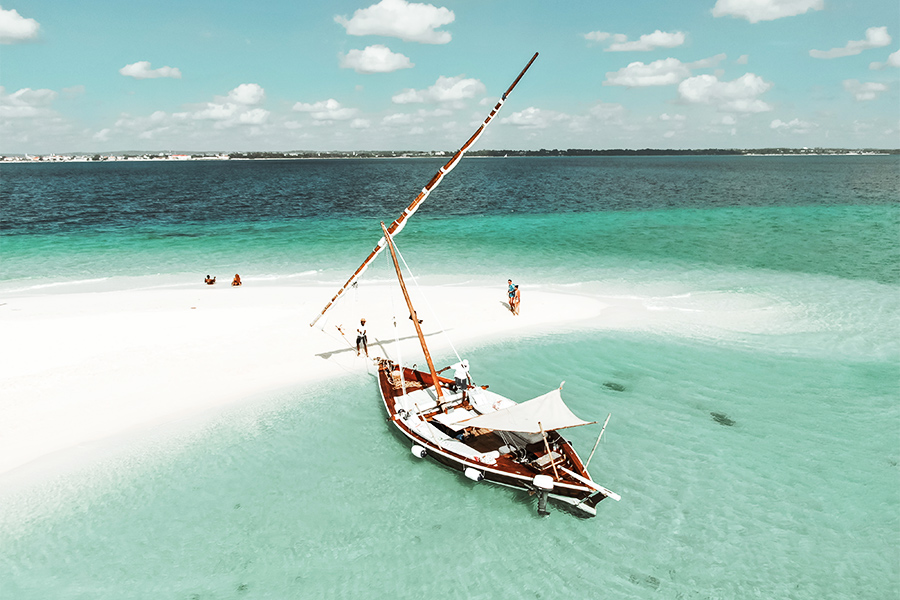
Life on the ocean / Image: ZCT

Jean-Louis Kromer, who advises within Zanzibar’s Ministry of Blue Economy and Fisheries, claimed that methods which use these damaging larger nets are not widespread. He said the majority of Zanzibar’s artisanal fishermen used less-invasive hand-held rods or long-lines (essentially lines with lots of individual hooked lines on them), with “less than five per cent” of the fleet made up of gillnets (which can snare unintended bycatch like turtles and dolphins).
Either way, Zanzibari fishermen appear as keen as their Kenyan counterparts to embrace long-lines. They told Belcher that they would happily change their fishing equipment to more sustainable versions – or versions that at least reduce the amount of bycatch – if these were freely available. Whether the island can follow through on this desire to be more at one with nature is the multi-million dollar question.